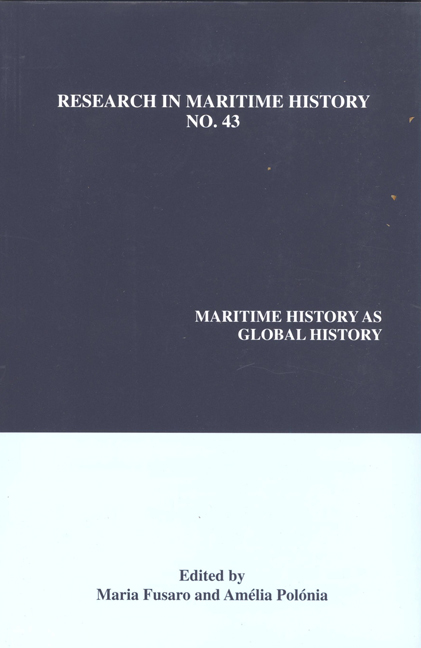Book contents
- Frontmatter
- Contents
- About the Editors
- Contributors' Notes
- “Maritime History: A Gateway to Global History?”
- “Behind the Atlantic Expansion: Flemish Trade Connections of Seville in 1620”
- “National and International Labour Markets for Sailors in European, Atlantic and Asian Waters, 1600-1850”
- “Maritime Expansion and (De)globalization? An Examination of the Land and Sea Trade in Seventeenth-Century Mughal India”
- “From Hold to Foredeck: Slave Professions in the Maritime World of the East India Company, c. 1660-1720”
- “Small Town Merchants, Global Ventures: The Maritime Trade of the New Julfan Armenians in the Seventeenth and Eighteenth Centuries”
- “Lighting up the World? Empires and Islanders in the Pacific Whaling Industry, 1790-1860”
- “Technological Advances in the Maritime Sector: Some Implications for Trade, Modernization and the Process of Globalization in the Nineteenth Century”
- “Lost in Calculation? Norwegian Merchant Shipping in Asia, 1870-1914”
- “Why Are the Major Oil Companies Selling Off their Fleets? The Case of Total”
- “Turning Maritime History into Global History: Some Conclusions from the Impact of Globalization in Early Modern Spain”
- “Maritime History as Global History? The Methodological Challenges and a Future Research Agenda”
“Small Town Merchants, Global Ventures: The Maritime Trade of the New Julfan Armenians in the Seventeenth and Eighteenth Centuries”
- Frontmatter
- Contents
- About the Editors
- Contributors' Notes
- “Maritime History: A Gateway to Global History?”
- “Behind the Atlantic Expansion: Flemish Trade Connections of Seville in 1620”
- “National and International Labour Markets for Sailors in European, Atlantic and Asian Waters, 1600-1850”
- “Maritime Expansion and (De)globalization? An Examination of the Land and Sea Trade in Seventeenth-Century Mughal India”
- “From Hold to Foredeck: Slave Professions in the Maritime World of the East India Company, c. 1660-1720”
- “Small Town Merchants, Global Ventures: The Maritime Trade of the New Julfan Armenians in the Seventeenth and Eighteenth Centuries”
- “Lighting up the World? Empires and Islanders in the Pacific Whaling Industry, 1790-1860”
- “Technological Advances in the Maritime Sector: Some Implications for Trade, Modernization and the Process of Globalization in the Nineteenth Century”
- “Lost in Calculation? Norwegian Merchant Shipping in Asia, 1870-1914”
- “Why Are the Major Oil Companies Selling Off their Fleets? The Case of Total”
- “Turning Maritime History into Global History: Some Conclusions from the Impact of Globalization in Early Modern Spain”
- “Maritime History as Global History? The Methodological Challenges and a Future Research Agenda”
Summary
If one wanted to explore the importance of the local in early globalization, few examples would be as striking as this one: the small Armenian town of Julfa on the Arax River was so important in the sixteenth century that it was marked on Abraham Ortelius’ 1570 Atlas of the World. In one of the earliest world atlases published, this minuscule village claimed its place among major destinations like Jerusalem and Istanbul. In the world as seen by the Antwerp mapmaker, it was a unique choice for a town of that scale, a centre important enough to be marked as “Chinla.” The Europeanized name “Chulfa” (as Julfa was often called) and China were melded, and Julfa now stood for all the silk from China. It was a small town of silk merchants who had traded raw silk on the Ottoman markets with Italians, Frenchmen and other Europeans since at least the sixteenth century. Because of their international trade, they were deported in 1604 from their hometown and settled in the Safavid capital of Isfahan in Iran. Since Philip Curtin's seminal study on Julfan Armenians in crosscultural exchanges, their commerce has often been viewed as a land-based “carrier” trade, not least because his chapter was entitled “Overland Trade of the Seventeenth Century: Armenian Carriers between Europe and East Asia.“ This essay argues for the successful participation of the Armenians in maritime trade and for the fact that it was European companies that longed to carry their goods. Their silk trade placed them on the world map, and their network stretched across many seas. As I discuss below, beyond Iran they could be found as a trading diaspora in most major ports from Europe to China. Nevertheless, despite a global network as late as the nineteenth century even as far away as Australia, where many settled, they still identified themselves by their local origin, as Julfan Armenians.
The situation of Julfa (or Old Julfa as it is often now called) and its wealth were well described by the seventeenth-century English traveller John Cartwright of Magdalen College, Oxford:
…and so we arrived at Chiufal [Julfa], a town situated in the frontiers between the Armenians and the Atropatians, and yet within Armenia, inhabited by Christians partly Armenians, partly Georgians: […]
- Type
- Chapter
- Information
- Maritime History as Global History , pp. 125 - 158Publisher: Liverpool University PressPrint publication year: 2010



